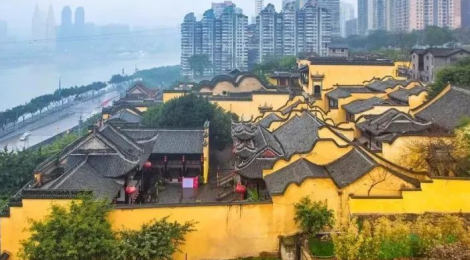
Huguang Guild Hall of Chongqing——a witness of a fusion history for three hundred years
Dear readers, have you ever noticed an architectural complex with black tile and yellow wall alongside the Yangtze River in Yuzhong District when passing the Dongshuimen Yangtze River Bridge or taking the Yangtze River Ropeway? It is built leaning the hill, and looks striking with the surrounding high-rise modern buildings. This is the destination we are going to explore for this issue of Chongqing Stories.
Chongqing Huguang Guild Hall is located at No. 4, Dongshuimen Main Street, Yuzhong District. It is the general name of a number of Qing Dynasty guild buildings represented by Yu Palace, covering an area of 8,561 square meters. According to historical data, the Guild Hall was first built in the 24th year of Emperor Qianlong of the Qing Dynasty (1759 AD), and then expanded in the 26th year of Daoguang (1846 AD). Why did the ancestors of the Qing Dynasty build the Guild Hall here? According to the “四川通志sì chuān tōng zhì”, a book written in Qing Dynasty recording all kinds of information in Sichuan area: “Since the Han and Tang Dynasties, there had been frequent wars. After the war at the end of Ming Dynasty, the area was thinly populated”. Although Sichuan Basin is the “Granary of Tianfu”, its population is not sufficient. In addition, the annual wars in the late Ming and early Qing Dynasties resulted in fewer people, barren fields and ruined cities. During the reign of Emperor Kangxi, faced with this situation, the governor of Sichuan, Zhang Dedi, proposed a plan to move people from other areas to Sichuan. The Emperor Kangxi agreed and issued an imperial edict in 1670 entitled “Recruiting People to Fill Sichuan in the Thirty-third Year “. Since then, a huge wave of population migration began.
In more than one hundred years, over one million people migrated to Sichuan, and most of them came from Hunan and Hubei provinces. Since Hubei and Hunan provinces were collectively called “Huguang Province” in the Ming Dynasty, this migration was called “Huguang Filling Sichuan”.
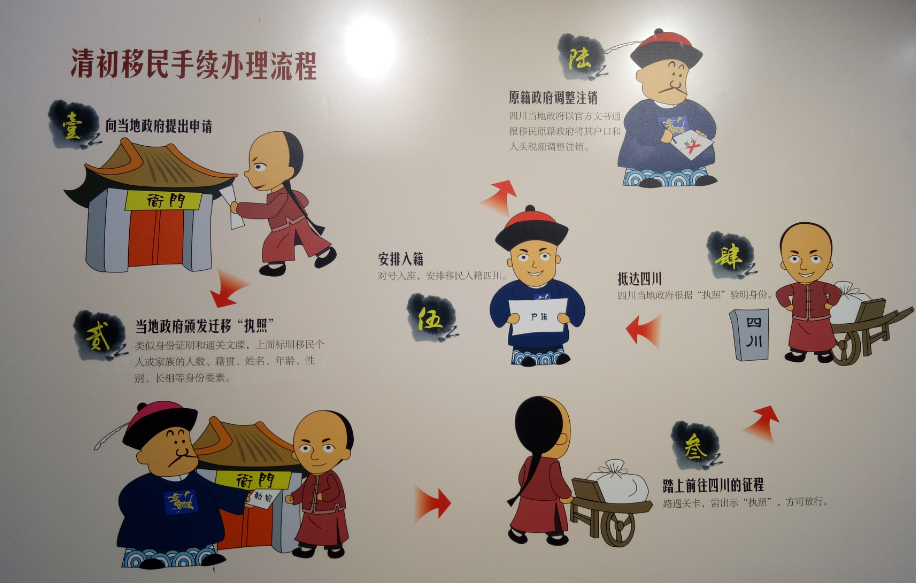
Since ancient times, the Chinese people have a tradition of “being attached to one’s native district and unwilling to leave”. After immigrants came to Sichuan, they also brought the customs and traditional culture of their native land to Sichuan. People from Huguang areas have the custom to sacrifice Dayu, praying for good weather, peaceful country and safe people as Dayu was known for his abilities to harness rivers. Dayu had once lived in Chongqing. At that time, he’s too busy to come back home even on the birth date of his son. It’s said that his wife came to the riverside every day to wait for him and eventually turned to a rock in the Yangtze River. The place where she gave birth was called “Birthstone,” later misidentified as Billiard stone.
After the Huguang people came to Chongqing, in order to keep the tradition of offering sacrifices to Dayu, in the 24th year of Emperor Qianlong of the Qing Dynasty (1759 AD), Yu’s Palace was built on the Yuzhong Peninsula on the north bank of the Yangtze River. The 12.5-meter-high and 14-meter-deep main hall of Yu’s Palace was made of wood imported from the Huguang region, as immigrants believed that only wood from their hometowns could make the hall blessed by the gods of their ancestors. The Hall is primitive with simplicity and lofty, the theater building is delicate and exquisite, engraved with the “24 filial piety”, the characters, landscape and bird painting in “Journey to the West” and “The Legend of Deification”. The tile used was in color of cyan and black. Though it had been rebuilt and expanded for three times, the tile still retained the original style.
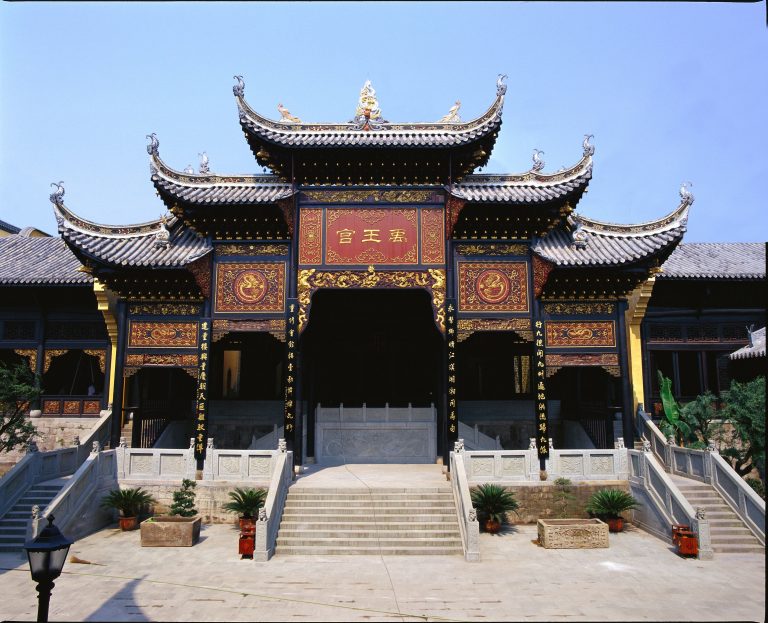
Qi ‘an Hall and Guangdong Hall are also representative buildings of the Hall. Because the county of Qi ‘an had been set up in Huangzhou of Hubei in the Tang Dynasty, the club built by immigrants from Huangzhou of Hubei was named Qi ‘an Office.
Guangdong Hall, also known as Nanhua Palace, was built with donations from Guangdong immigrants. They started the construction of the hall from the beginning of the wave of Huguang immigrants in the 16th year of the Shunzhi Period of the Qing Dynasty (AD 1659) until it was formally completed in the reign of Kangxi.
The highlights of both halls are the theater buildings. The theater stage in Qi ‘an Hall is the most intact with the most exquisite wood carvings stage, flanked by two deep anaglyph, on the right is the “apricot blossom village”, depicting the image of the poem “Qingming Festival” written by the great poet Du Mu in Tang Dynasty. The poem shows life scenes of the migration. On the left is the “wind gate”, which is carved with the city tower of Chongqing and the well-arranged folk houses in the mountain city. It is a beautiful picture of the typical mountain city of Chongqing, expressing the immigrants’ love for this land and their vision of building a better life.
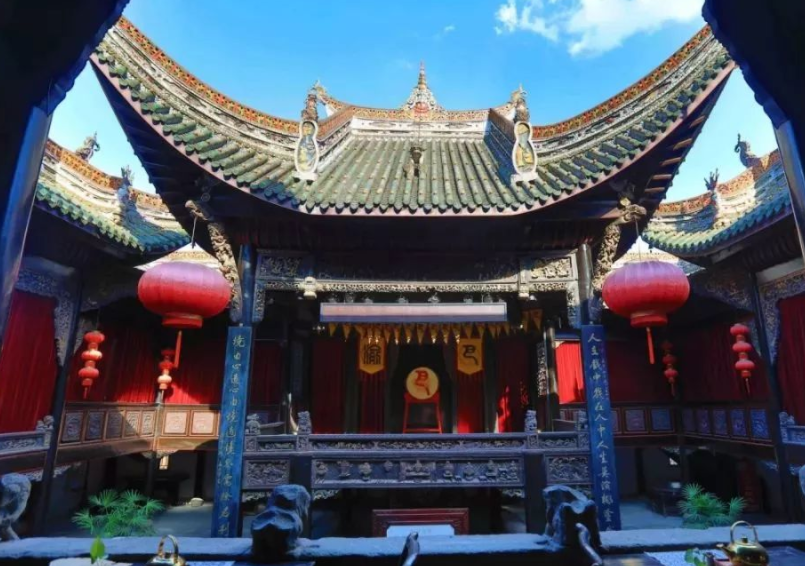
In addition, there are Jiangnan Guild Hall, Lianghu Guild Hall, Jiangxi Guild Hall and other buildings. The arrival of immigrants, not only brought sufficient population, consolidate the food production for Sichuan and Chongqing area, but also promoted the development of commerce of the area. It is said that before immigration, weights for commercial use in Chongqing are different. It was Huguang Guild Hall take the lead and developed standard weights.
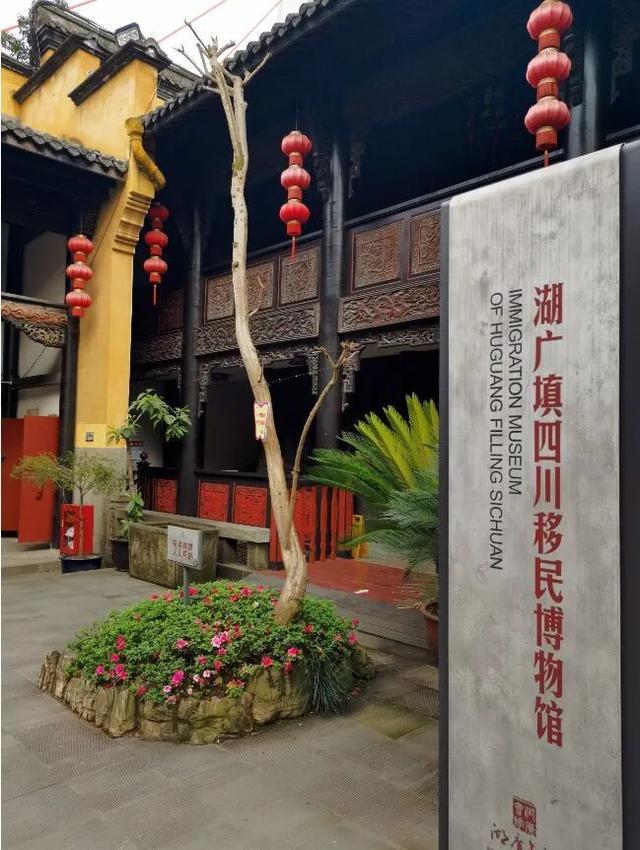
Thus it can be seen that Huguang Guild Hall is not only an important place for immigrants to pay homage to gods, worship ancestors and express their homesickness, but also an important carrier and proof of civilization inheritance. It reveals the information of Chinese classical architecture, traditional aesthetics, regional folklore and other aspects with its grand and exquisite architecture, and is also a witness of the development of Chongqing, a cultural melting pot.
Written by Zhang Yangxin




